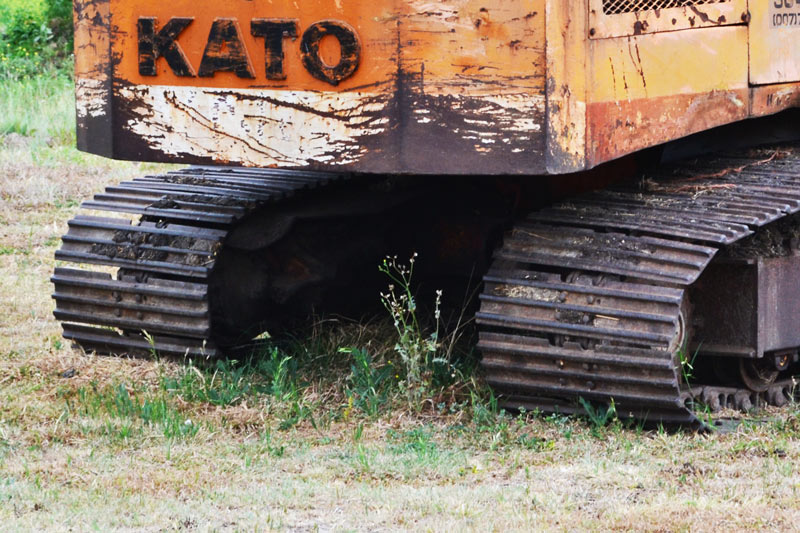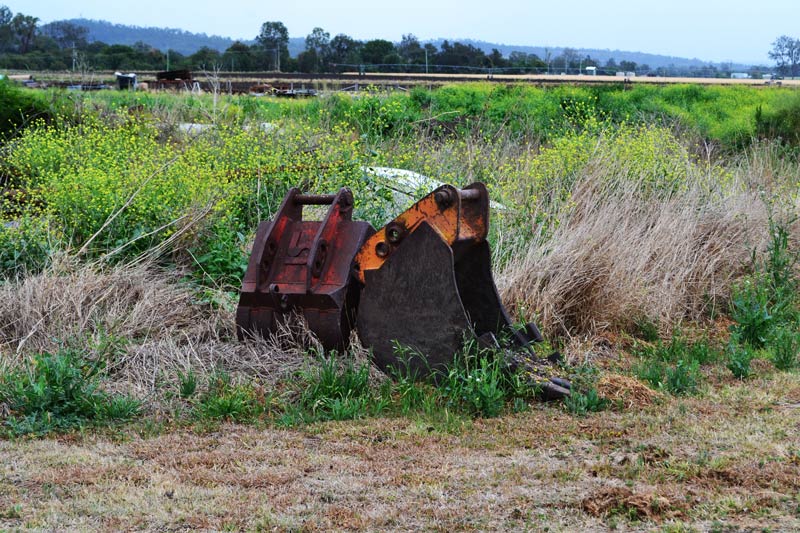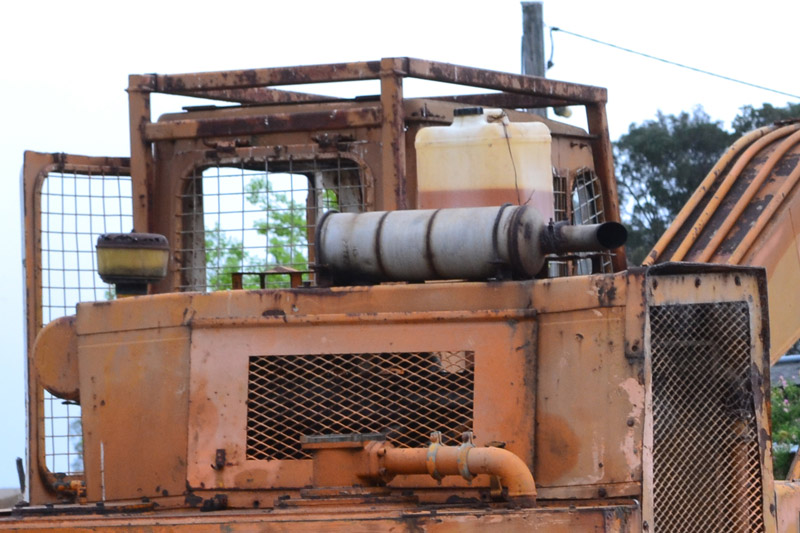Ron Horner just can’t get enough of old Kato excavators. Here he checks out a 1979 550G found on a Queensland farm
It never ceases to amaze me what you can find when you really start to scratch the surface of the Australian landscape.
On one of Ronnie’s Road Trips through Queensland I was fortunate to come across an old Kato 550G swampy excavator lying in a paddock and buried up to its side panels in grass and weeds.
At first I didn’t register exactly what I was to about to uncover, as all I could see was the faded boom of an excavator sticking above the grass line and the unmistakable old Kato-style cabin. Naturally, I made a beeline to the property owner’s house in hope of a closer look.
 |
|
The swamp tracks are somewhat wider than normal at just under a metre wide
|
Meet and greet
I was met with a hesitant and somewhat cautious greeting as I set to the task of explaining my reasons for entering the small but well-set-out lucerne and cropping farm located just a few kilometres off the highway.
Tensions eased and apology accepted, I was then treated to a quick overview of the farming operations before heading down to the old digger in the paddock.
The owner offered to grab the slasher and cut a swathe through the overgrowth to gain safe access in an effort to frighten off the ‘kingys’ and away we went. Interestingly enough, when we cleared an area closer to one of the outlying sheds we found the rest of the missing side panels.
Among the litter of what some people would call junk but contractors and cockies call the ‘spare parts yard’ or ‘on-site op shop’ was the near 40-year-old gem, once the pride and joy of the Kato fleet – an original 14-tonne 550G Kato swampy excavator.
 |
|
No, that is not a comfortable cab!
|
History in the finding
Regular TradeEarthmovers.com.au readers will know that I’m a Kato nut, having used them at the start of my earthmoving career. In fact, we’ve previously featured both the Kato 550G excavator and Kato 750G excavator.
Although this 550G is by far not the oldest of the Katos I have found on a road trip – the 750G was a 1968 model – it definitely holds its place up there as a machine of significance.
I was informed that the origins of the machine were very sketchy. Before being bought by the current owner, it was left behind by a contractor on a site close to the Gold Coast almost 20 years previously and never collected.
The land on which the excavator was located had been re-sold many times and the excavator basically forgotten. Blasphemy!
The present owner bought the machine – a non goer and deemed more suited for parts – for a pittance and brought it back to the farm. After a bit of time spent doing basic repairs and sorting out the typical issues related to extensive downtime and non-servicing, he had the little Kato up and running, albeit for farm use only.
It’s rarely used these days, other than for some small drainage channel excavations.
Seeing the machine definitely stirred up the blood in this old body and took me back to my earliest days when I was introduced to Kato excavators way back in 1974/5.
 |
|
The original Banbury Engineering buckets are clearly identified
|
Walkaround
The poor old digger has definitely seen better years. The cab is severely rusted, there are no side covers or panels in some areas, there’s no glass in sight, and the fuel tank is quite apparently non-operational (the dead giveaway is the 20-litre plastic drum of diesel located on the top of the engine cover with a drain hose to the fuel pump).
But, as I said, it was and is a goer.
Still clearly visible along the boom is the original contractor’s name (not the previous owner) slowly fading with age and weather along with the old Brisbane six-digit telephone number.
What is significant is that this would have to be one of the first original swamp tracked excavators bought into Australia in the mid-to-late 1970s or early ’80s and (although not confirmed) it seems to have been worked as one of the first hydraulic swamp excavators on the Gold Coast during the peak of the canal developments in that era.
Running a Mitsubishi engine pushing out a mere 90hp delivered to a simple commercial-grade single hydraulic pump, it appears these days to be a simplistic as an excavator could be … but in its heyday this was the ‘King of the Swamps’.
The engine bay sits quite high and restricts the operator’s view (this later became more streamlined), the counterweight houses the hydraulic oil tank, while the fuel tank is located on the far side opposite the cab.
Drive sprockets, front idlers and all rollers on this machine are in excellent condition but it’s the track plate size that makes it a standout from the rest.
At just under a metre wide, the swamp tracks are somewhat wider than the track plates fitted to a conventional 550 excavator. They give the machine greater flotation attributes by creating a very low ground pressure.
These were the forerunner for the construction of the amphibious or floating excavators that are so popular today.
This Kato model’s ‘fully hydraulic’ Hy-Dash track motors were a first in the country. Prior to this model Kato ran a chain drive to power up the travel motors, so this was indeed an innovative step in the advancement of excavators worldwide.
These track motors were enclosed in the later models but in the early days they were protruding and would get hung up on logs or rocks, causing grief for some operators. One had to become very aware of this possibility and take measures to eliminate any problems.
On this particular machine the problem was mitigated to an extent by the width of the track plates.
 |
|
The fuel tank has been replaced with a 20-litre plastic drum of diesel located on the top of the engine cover with a drain hose to the fuel pump
|
On the job
Operation of this little digger is again at the basic end of the scale with hydraulic power delivered to the valve bank and connected by adjustable mechanical rods on the underside of the foot- and hand-control levers in the cab.
The operator merely pulls a lever of choice and the corresponding valve opens up to deliver oil to the hydraulic ram … simple, simple, simple!
I can tell you that Michael Jackson had nothing on a good Kato operator in full flight.
The controls in the Kato range of that period were all foot- and hand-operated long-stick controls with a ‘push forward – pull back’ action and all located forward of the operator protruding out of the floor between the seat and the cabin front window.
Left to right the controls were: slew (hand), dipper arm (foot), 2x travel (hand and foot), bucket (foot) and boom (hand).
 |
|
Here’s one we prepared earlier – Ronnie’s original Kato HD-550G
|
Creature comforts (not)
‘Ergonomic’ wasn’t even a word in those days and operator comfort would not hold up on any construction or mine site of today.
The apple-box seat resembles something out of the Flintstones and, believe me, caused many an operator a crook back … but it was a huge improvement on anything else that was on the market.
Today we are spoiled for choice and comfort. The smooth, direct-operating controls, high power, tinted windows, plush adjustable seating, and air-conditioned and climate-controlled cabs make our lives unbelievably easy – but back then it was painfully uncomfortable.
Without seat adjustment or back support there were many days the operators suffered from excruciating back pain until numbness took control and it became more of the norm. You just grew to live with the pain and forget the discomfort.
The dashboard of the Kato 550G was floor-mounted and located to the right side of the operator. Very basic gauges, hand throttle with lock out, unique Kato Key electronic start, pull-stop engine cut-off, light switch for lights mounted on the boom and hydraulic tank, no radio, no air-conditioning, no heater, but this model did have a fully opening front windscreen and slide windows, lockable doors and good vision for the operator.
Anyone operating earthmoving gear in those days was lucky to have an enclosed cabin. Most became first-rate candidates for melanoma and cancer later on in life. (I am living proof of that.)
As I said before, some of these so-called ‘creature comforts’ may sound horrific to the operators of today but, believe me, they were a huge improvement. Getting your bum into a fully hydraulic excavator with sealed weatherproof cab would be like running a D11 of today.

